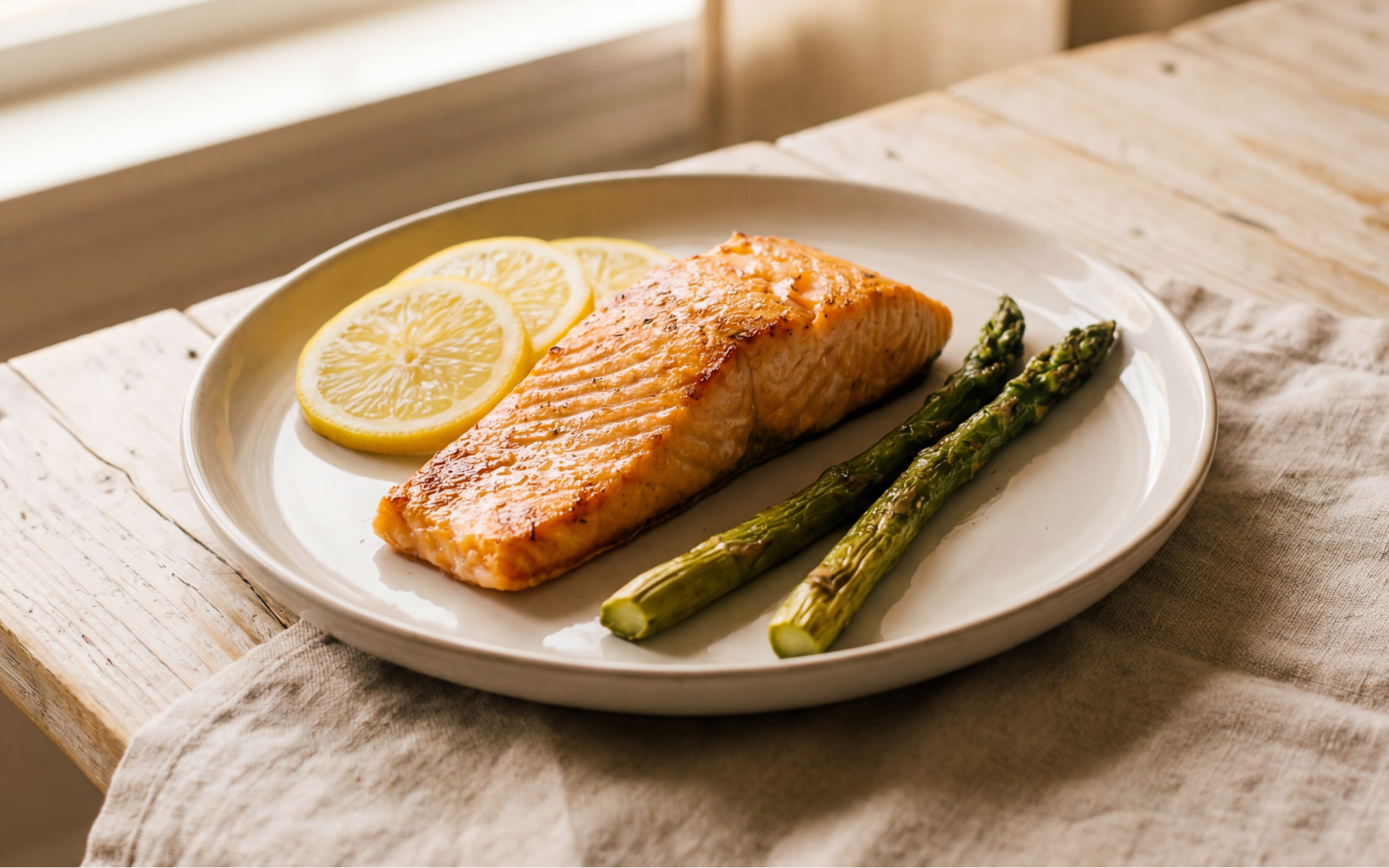Many people try to lose weight or achieve better health through restrictive diets and rigorous exercise. However, imagine a scenario where eating cheeseburgers or pizzas and not putting on weight is possible. Does this sound intriguing? If yes, then the one-meal-a-day (OMAD) diet may be an option for you.
In the realm of diets and wellness trends, the OMAD diet has gained significant traction in recent years. It is often hailed as a convenient and effective approach to weight loss and stands out for its simplicity and purported benefits. However, as with any dietary regimen, it has its pros and cons.
Below, we delve deep into the world of OMAD, exploring its principles, potential advantages, drawbacks, recommended food choices, and meal plans.
What Is the OMAD Diet?
The OMAD diet is a type of intermittent fasting. The fasting period lasts for 23 hours a day, with one hour to eat everything for the day in just one meal. You can make your one-time meal a pizza, a burger, or a nutritious balanced meal rich in vegetables, complex carbs, lean proteins, and healthy fats.
It is claimed that by curbing your caloric consumption during the whole day, you can enjoy one single meal, often consumed in a 1-hour window, and not put on weight at the same time. Most dieters do this based on the following principle: don’t eat at night, skip breakfast, and eat the first and only meal in the middle of the day.
This extreme form of fasting compresses eating into a brief timeframe, with the aim of maximizing the body’s fasting state and its potential benefits. While the specific composition of the meal can vary, proponents emphasize the importance of obtaining essential nutrients within this limited time frame.
Read More: Different Types of Diets: The Lowdown on the Most Talked-About Weight Loss Strategies
Is OMAD Intermittent Fasting?
Yes, the OMAD diet is a form of intermittent fasting. Intermittent fasting encompasses various dietary patterns that involve alternating periods of eating and fasting. The OMAD diet is an extreme variant of intermittent fasting that is characterized by a prolonged fasting period of approximately 23 hours, followed by a brief eating window of one hour.
During the fasting period of the OMAD diet, you must abstain from consuming any calories, allowing only non-caloric beverages such as water, unsweetened herbal tea, or black coffee.
While the OMAD diet shares similarities with other forms of intermittent fasting, such as the 16/8 method (16 hours fasting, 8 hours eating) or alternate-day fasting, it distinguishes itself by its extreme restriction to one meal a day. As with any dietary approach, it’s important to consider individual preferences, lifestyle factors, and health history and goals when making a decision about whether the OMAD diet or intermittent fasting is suitable for you. We recommend discussing any major dietary changes or fasting regimen with your healthcare provider.
Purported Benefits of This Diet
Advocates of the OMAD diet tout numerous potential benefits, including weight loss, enhanced insulin sensitivity, reduced inflammation, improved cognitive function, and increased longevity. By restricting the eating window, proponents argue that the body taps into stored fat reserves for energy, which leads to more efficient fat loss in comparison to traditional calorie-restricted diets.
The OMAD diet is believed to gently stress your cells, which may increase their stress resistance (1). This is called hormesis. Furthermore, single meal enthusiasts believe that eating 1 meal a day results in a wider number of advantages for your health:
Autophagy
Fasting regimens such as eating once a day are believed to promote the process of autophagy. This is how your body breaks down and recycles old or damaged cell components(2). Increasing autophagy theoretically has some benefits for disease prevention and longevity, but more research is required to gain an understanding of how fasting affects autophagy and if there are any measurable health benefits.
Metabolic health
Intermittent fasting regimens such as the one-meal-a-day diet may have benefits for metabolic health. Alternating between burning carbohydrates for fuel and burning fat for fuel is believed to help increase your metabolic flexibility, which is the ability to adapt to changes in fuel availability and metabolic demand. Studies have found that intermittent fasting may help decrease blood sugar, lower triglyceride levels (9), increase HDL (good) cholesterol, decrease systolic blood pressure, and improve insulin sensitivity. Together, these improvements may help reduce the risk of chronic diseases such as type 2 diabetes and heart disease (4).
BetterMe will keep you laser-focused on your weight loss journey, providing nutrient-packed meal plans, fat-blasting workouts, galvanizing challenges, and much more. Try using the app and see for yourself!
Easier Meal Planning
Eating once a day gives you a unique opportunity to get rid of the stress that is associated with finding healthy food in the workplace or restaurants. This means that you only need to plan 1 meal a day, so you can sleep before breakfast and simplify your grocery plan.
Weight Control
On the OMAD diet, you’re likely to eat fewer calories, which can promote weight loss. You’ll probably find yourself unable to consume the same daily calorie amount in one meal that you did with 3 meals.
Improvement of Digestive Symptoms
Some individuals report improvements in digestive issues such as bloating, gas, and indigestion when they follow a fasting diet. On the other hand, eating one large meal per day may worsen digestive symptoms such as heartburn and indigestion for others.
Enhanced Cognitive Function
Some proponents claim that fasting promotes mental clarity and focus. However, this is subjective, and others may find that hunger and low energy levels negatively impact their productivity and focus.
What Foods to Eat on an OMAD Diet
While you can eat absolutely anything under the sun during your one-hour eating period, choosing nutrient-dense foods when following the OMAD diet will help ensure your intake of essential nutrients within the restricted eating window. Emphasizing whole, minimally processed foods such as lean proteins, fruits, vegetables, whole grains, and healthy fats can help meet your nutritional needs while promoting satiety and overall well-being.
You’re more likely to gain or remain at the same weight if you fill up your plate with high-calorie, high-fat foods during your one-hour period. In contrast, research has found that opting for a Mediterranean diet can help with weight loss and is one of the better diets for overall health and disease prevention (12).
If you’re following the Mediterranean diet, you can fill up your plate with:
- Fruits
- Vegetables
- Lean meats
- Nuts and legumes
- Olive oil
- Fatty fish and other seafood
- Whole grains
Explore the benefits of the Mediterranean diet, which offers a delicious and sustainable approach to nourishing your body and soul.
Foods to Avoid or Limit on OMAD
- Ultra-processed foods that are high in added sugars, unhealthy fats, and sodium, but low in important nutrients
- Sugar-sweetened beverages
- Alcohol
What Is the OMAD Diet Plan?
Sure, your one meal a day could be a delicious burger, a massive pizza, or a fancy steak, but creating a balanced diet plan for the OMAD diet is essential to ensure you meet your daily nutritional needs in a single meal. BetterMe has put together a sample diet plan to give you inspiration for your OMAD journey:
- Day 1: Grilled chicken breast or baked salmon seasoned with herbs and spices with a side of one roasted potato topped with plain yogurt and roasted broccoli. Cantaloupe for dessert.
- Day 2: Quinoa or brown rice pilaf with tofu and mixed vegetables (bell peppers, broccoli, carrots) sauteed in 1 tablespoon of olive oil.
- Day 3: Tuna salad with homemade olive oil mayonnaise on whole-wheat bread. Pair it with a salad or vegetable soup. End with one pear.
- Day 4: 2 Eggs (the way you like them) and 2 pieces of bacon with avocado on whole-wheat toast and sauteed mushrooms. End with two kiwis.
- Day 5: Pan-seared salmon with sauteed spinach and wild rice. End with a cup of blackberries and half a cup of yogurt.
- Day 6: Rack of lamb with sauteed asparagus, accompanied by one medium roasted russet potato. End the meal with a few pieces of dark chocolate and half a cup of strawberries. (13)
- Day 7: Ribeye steak seared in ghee paired with roasted vegetables and one large sweet potato roasted in olive oil. End with a cup of raspberries.
Some Tips to Consider:
- Calorie Consideration: Calculate your daily calorie needs and ensure that your OMAD meal provides adequate energy to support your activity level and weight goals.
- Portion Control: Be mindful of portion sizes to prevent overeating and promote satiety. Use smaller plates and bowls to control portions visually.
- Meal Timing: Select a consistent time for your OMAD meal in order to establish a routine. Experiment with different meal timings to find out what works best for your schedule and preferences.
- Hydration: Stay hydrated throughout the day by drinking water, herbal tea, or infused water with lemon, cucumber, or mint. Avoid sugary beverages and excessive amounts of caffeine.
- Flexibility: Finally, be flexible with your OMAD diet. Occasional indulgences or deviations can disrupt your routine, but the key is to strive for consistency over perfection. Listen closely to your body’s hunger and satiety signals.
Learn how the principles of a no-sugar diet can transform your health and vitality.
BetterMe app is a foolproof way to go from zero to a weight loss hero in a safe and sustainable way! What are you waiting for? Start transforming your body now!
What Is the Best Time to Eat During OMAD?
Determining the optimal time to eat during the OMAD diet can vary depending on individual preferences, lifestyle factors, and metabolic responses. While there is no one-size-fits-all answer, some practitioners advocate consuming the OMAD meal earlier in the day, typically at around traditional lunchtime or in the early afternoon (14). Proponents of this approach argue that eating earlier allows for better alignment with natural circadian rhythms, which promotes efficient digestion and nutrient absorption during the body’s peak metabolic state.
Conversely, there’s a group of people who prefer to schedule their OMAD meal in the evening, closer to bedtime, citing reasons such as convenience, social factors, or personal preference. Consuming this single meal later in the day may provide a sense of satisfaction and satiety during evening hours, which potentially reduces the temptation to snack or overeat later in the day. Some individuals also find that eating in the evening aligns better with their daily schedule and allows for more leisurely enjoyment of the meal without time constraints.
Ultimately, the best time to eat is subjective and may require experimentation to determine what works best for your unique needs and preferences. Listening to your body’s hunger cues, considering your lifestyle factors, and prioritizing consistency in meal timing can help optimize adherence and outcomes on the OMAD diet.
Discover the key components of a balanced diet, striking the perfect harmony between essential nutrients, whole foods, and mindful eating practices for optimal well-being.
Possible Drawbacks of the Diet
As with any diet, the OMAD diet is useful, but it can be dangerous. It doesn’t suit everyone and there’s very little scientific evidence to support the one-meal-a-day diet, which is quite restrictive (6). There are some basic risks and potential negative consequences connected with this type of model:
- You ignore your body’s hunger signals. When you can eat nutrients for only one hour a day, you’ll probably eat as much as you need, which is not entirely suitable for your body. It won’t understand whether you’re hungry or full.
- You can skip significant nutrients. It’s recommended to eat at least 5 servings of vegetables and fruits per day to get enough essential vitamins, minerals, antioxidants, and phytonutrients. Don’t forget about grains, beans, nuts, seeds, and dairy products (or their alternatives).
- Inadequate protein intake, energy intake, or prolonged fasting periods can increase the risk of muscle loss.
- Over time, the body may adapt to the OMAD diet by slowing down metabolic rate in response to prolonged fasting periods and reduced calorie intake. This metabolic adaptation can hinder weight loss efforts and make weight maintenance challenging.
- The strict eating pattern of the OMAD diet may contribute to disordered eating behaviors, such as binge eating or feelings of guilt associated with food consumption. Individuals with a history of eating disorders should approach the OMAD diet (or any diet) with caution and seek guidance from a healthcare professional (11).
- Finally, the strict eating schedule of the OMAD diet can pose challenges in social situations, as it could conflict with typical meal times and social gatherings. Dining out or attending events can become complicated, which could potentially lead to feelings of isolation or exclusion.
Read more: How Much Protein Should I Eat A Day to Build Muscles – A Comprehensive Guide
FAQs
What is the OMAD diet?
The OMAD (one-meal-a-day) diet involves consuming all your daily nutritional needs in a single meal, typically within a one-hour eating window, followed by a fasting period of approximately 23 hours.
What are the potential benefits of the OMAD diet?
Potential but unproven benefits include weight loss, improved metabolic health, increased insulin sensitivity, enhanced cognitive function, and increased longevity.
Can you lose weight by eating one meal a day?
The OMAD diet may help you lose weight by lowering your overall daily consumption. However, it also depends on the foods you choose to add to your plate. You should listen to your body and make sure you don’t harm it. Talk to your doctor to get professional advice and possible tips.
What are the potential drawbacks of the OMAD diet?
Drawbacks include nutrient deficiencies, hunger and energy fluctuations, social and lifestyle impacts, and potential muscle loss.
What foods should I eat on the OMAD diet?
You should prioritize nutrient-dense foods, such as lean proteins, complex carbohydrates, healthy fats, fruits, and vegetables, to ensure adequate intake of essential nutrients within the limited eating window.
What is the best time to eat during the OMAD diet?
The optimal eating time can vary. Some people prefer consuming their OMAD meal earlier in the day to align with circadian rhythms, while others prefer to eat it in the evening for convenience or social reasons.
Can I drink coffee on the OMAD diet?
Yes, black coffee is generally allowed during the fasting period of the OMAD diet, as it contains minimal calories and can help suppress appetite and increase alertness. However, you should avoid adding sugar, milk, or cream, as they may break the fast.
Do I need to count calories on OMAD?
There’s no need to count calories with the OMAD diet. You should simply follow its only rule: eat just one meal once a day.
How can I make OMAD more effective?
To enhance effectiveness, focus on nutrient density, portion control, hydration, mealtime consistency, mindful eating, regular physical activity, and adequate sleep. Experiment with meal timing, food choices, and lifestyle adjustments to optimize the diet. Consult your healthcare provider for individualized recommendations.
The Bottom Line
In conclusion, the OMAD diet offers a novel approach to intermittent fasting with the potential for weight loss, metabolic improvements, and other possible but unproven health benefits. However, it also presents challenges related to nutrient adequacy, adherence, and individual tolerance.
As with any other diet, the OMAD diet isn’t for everyone. You should consult your healthcare provider first before starting this diet and pay attention to several factors so that your health is not harmed. However, the right approach may give you the chance to achieve your goals. This could be weight loss, better health, or actual well-being. With careful planning, mindfulness, and attention to nutritional quality, the OMAD diet could be an option for you.
DISCLAIMER:
This article is intended for general informational purposes only and does not serve to address individual circumstances. It is not a substitute for professional advice or help and should not be relied on for making any kind of decision-making. Any action taken as a direct or indirect result of the information in this article is entirely at your own risk and is your sole responsibility.
BetterMe, its content staff, and its medical advisors accept no responsibility for inaccuracies, errors, misstatements, inconsistencies, or omissions and specifically disclaim any liability, loss or risk, personal, professional or otherwise, which may be incurred as a consequence, directly or indirectly, of the use and/or application of any content.
You should always seek the advice of your physician or other qualified health provider with any questions you may have regarding a medical condition or your specific situation. Never disregard professional medical advice or delay seeking it because of BetterMe content. If you suspect or think you may have a medical emergency, call your doctor.
SOURCES:
- Dietary Factors, Hormesis and Health (2009, ncbi.nlm.gov)
- Short-term Fasting Induces Profound Neuronal Autophagy (2010, pubmed.ncbi.nlm. nih.gov)
- Intermittent fasting and caloric restriction ameliorate age-related behavioral deficits in the triple-transgenic mouse model of Alzheimer’s disease (2007, sciencedirect.com)
- Intermittent fasting dissociates beneficial effects of dietary restriction on glucose metabolism and neuronal resistance to injury from calorie intake (2003, pnas.org)
- Fasting: Molecular Mechanisms and Clinical Applications (2015, ncbi.nlm.nih.gov)
- Potential Benefits and Harms of Intermittent Energy Restriction and Intermittent Fasting Amongst Obese, Overweight and Normal Weight Subjects—A Narrative Review of Human and Animal Evidence (2017, ncbi.nlm.nih.gov)
- The effect of intermittent energy and carbohydrate restriction v. daily energy restriction on weight loss and metabolic disease risk markers in overweight women (2013, ncbi.nlm.nih.gov)
- Intermittent Fasting: The Choice for a Healthier Lifestyle (2018, ncbi.nlm.nih.gov)
- Food Timing, Circadian Rhythm and Chrononutrition: A Systematic Review of Time-Restricted Eating’s Effects on Human Health (2020, mdpi.com)
- Fasting as a Therapy in Neurological Disease (2019, ncbi.nlm.nih.gov)
- Is Eating One Meal a Day a Safe and Effective Way to Lose Weight? (2023, healthline.com)
- OMAD Diet: What You Need To Know (2023, health.com)
- OMAD meals: 7 Day Plan (2022, doctorkiltz.com)
- OMAD And 20:4 Intermittent Fasting (2022, examine.com)










